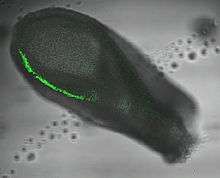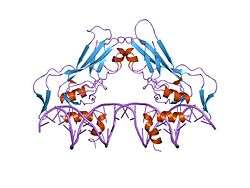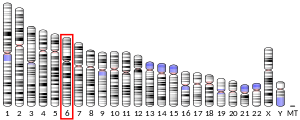Brachyury
Brachyury (from Greek βραχύς, "short" and ουρά, "tail") is a protein that, in humans, is encoded by the TBXT (T-box transcription factor T) gene.[5][6] Brachyury functions as a transcription factor within the T-box family of genes.[7] Brachyury homologs have been found in all bilaterian animals that have been screened, as well as the freshwater cnidarian Hydra.[7]
History
The brachyury mutation was first described in mice by Nadezhda Alexandrovna Dobrovolskaya-Zavadskaya in 1927 as a mutation that affected tail length and sacral vertebrae in heterozygous animals. In homozygous animals the brachyury mutation is lethal at around embryonic day 10 due to defects in mesoderm formation, notochord differentiation and the absence of structures posterior to the forelimb bud (Dobrovolskaïa-Zavadskaïa, 1927). The name brachyury comes from the Greek brakhus meaning short and oura meaning tail.
In 2018 HGNC updated the human gene name from T to TBXT, presumably to overcome difficulties associated with searching for a single letter gene symbol. It is assumed that the mouse nomenclature will also be updated in due course.
The mouse T gene was cloned by Bernhard Herrmann and colleagues[8] and proved to encode a 436 amino acid embryonic nuclear transcription factor. T binds to a specific DNA element, a near palindromic sequence TCACACCT through a region in its N-terminus, called the T-box. T is the founding member of the T-box family which in mammals currently consists of 18 T-box genes.
The crystal structure of the human brachyury protein was solved in 2017 by Opher Gileadi and colleagues at the Structural Genomics Consortium in Oxford.[9]

Role in Development
The gene brachyury appears to have a conserved role in defining the midline of a bilaterian organism,[10] and thus the establishment of the anterior-posterior axis; this function is apparent in chordates and molluscs.[11] Its ancestral role, or at least the role it plays in the Cnidaria, appears to be in defining the blastopore.[7] It also defines the mesoderm during gastrulation.[12] Tissue-culture based techniques have demonstrated one of its roles may be in controlling the velocity of cells as they leave the primitive streak.[13][14] It effects transcription of genes required for mesoderm formation and cellular differentiation.
Brachyury has also been shown to help establish the cervical vertebral blueprint during fetal development. The number of cervical vertebrae is highly conserved among all mammals; however a spontaneous vertebral and spinal dysplasia (VSD) mutation in this gene has been associated with the development of six or fewer cervical vertebrae instead of the usual seven.[15]
Expression
In mice T is expressed in the inner cell mass of the blastocyst stage embryo (but not in the majority of mouse embryonic stem cells) followed by the primitive streak (see image). In later development expression is localised to the node and notochord.
In Xenopus laevis Xbra (the Xenopus T homologue, also recently renamed t) is expressed in the mesodermal marginal zone of the pre-gastrula embryo followed by localisation to the blastopore and notochord at the mid-gastrula stage.
Orthologs
The Danio rerio ortholog is known as ntl (no tail)
Role in disease
Cancer
Brachyury is implicated in the initiation and/or progression of a number of tumor types including chordoma, germ cell tumors, hemangioblastoma, GIST, lung cancer, small cell carcinoma of the lung, breast cancer, colon cancer, hepatocellular carcinoma, prostate cancer, and oral squamous carcinoma.[16]
In breast cancer brachyury expression is associated with recurrence, metastasis and reduced survival.[17][18][19][20] It is also associated with resistance to tamoxifen[21] and to cytotoxic chemotherapy.[17]
In lung cancer brachyury expression is associated with recurrence and decreased survival.[22][23][24][25] It is also associated with resistance to cytotoxic chemotherapy,[26] radiation,[27] and EGFR kinase inhibitors.[22]
In prostate cancer brachyury expression is associated with Gleason score, perineural, invasion and capsular invasion.[28] It is also associated with resistance to cytotoxic chemotherapy.[29]
In addition to its role in common cancers, brachyury has been identified as a definitive diagnostic marker, key driver and therapeutic target for chordoma, a rare malignant tumor that arises from remnant notochordal cells lodged in the vertebrae. The evidence regarding brachyury's role in chordoma includes:
- Brachyury is highly expressed in all chordomas except for the dedifferentiated subtype, which accounts for less than 5% of cases[30]
- Germ line duplication of the brachyury gene is responsible for familial chordoma.[31]
- A germline SNP in brachyury is present in 97% of chordoma patients.[32]
- Somatic amplifications of brachyury are seen in a subset of sporadic chordomas either by aneuploidy or focal duplication.[33]
- Brachyury is the most selectively essential gene in chordoma relative to other cancer types.[34]
- Brachyury is associated with a large superenhancer in chordoma tumors and cell lines, and is the most highly expressed superenhancer-associated transcription factor.[34]
Brachyury is an important factor in promoting the epithelial–mesenchymal transition (EMT). Cells that over-express brachyury have down-regulated expression of the adhesion molecule E-cadherin, which allows them to undergo EMT. This process is at least partially mediated by the transcription factors AKT[35] and Snail.[36]
Overexpression of brachyury has been linked to Hepatocellular carcinoma (HCC, also called malignant hepatoma), a common type of liver cancer. While brachyury is promoting EMT, it can also induce metastasis of HCC cells. Brachyury expression is a prognostic biomarker for HCC, and the gene may be a target for cancer treatments in the future.[35]
Role as a therapeutic target
Because brachyury is expressed in tumors but not in normal adult tissues it has been proposed as a potential drug target with applicability across tumor types. In particular, brachyury-specific peptides are presented on HLA receptors of cells in which it is expressed, representing a tumor specific antigen. Various therapeutic vaccines have been developed which are intended to stimulate an immune response to brachyury expressing cells.[16]
See also
- Homeobox protein NANOG
- POU5F1
- SOX2
- MIXL1
- GSC
- EOMES
- Transcription factors
- Gene regulatory network
- Bioinformatics
- Chordoma
References
- GRCh38: Ensembl release 89: ENSG00000164458 - Ensembl, May 2017
- GRCm38: Ensembl release 89: ENSMUSG00000062327 - Ensembl, May 2017
- "Human PubMed Reference:". National Center for Biotechnology Information, U.S. National Library of Medicine.
- "Mouse PubMed Reference:". National Center for Biotechnology Information, U.S. National Library of Medicine.
- "Entrez Gene: T".
- Edwards YH, Putt W, Lekoape KM, Stott D, Fox M, Hopkinson DA, Sowden J (March 1996). "The human homolog T of the mouse T(Brachyury) gene; gene structure, cDNA sequence, and assignment to chromosome 6q27". Genome Research. 6 (3): 226–33. doi:10.1101/gr.6.3.226. PMID 8963900.
- Scholz CB, Technau U (January 2003). "The ancestral role of Brachyury: expression of NemBra1 in the basal cnidarian Nematostella vectensis (Anthozoa)". Development Genes and Evolution. 212 (12): 563–70. doi:10.1007/s00427-002-0272-x. PMID 12536320.
- Herrmann BG, Labeit S, Poustka A, King TR, Lehrach H (February 1990). "Cloning of the T gene required in mesoderm formation in the mouse". Nature. 343 (6259): 617–22. Bibcode:1990Natur.343..617H. doi:10.1038/343617a0. PMID 2154694.
- Gileadi O, Bountra C, Edwards A, Arrowsmith CH, von Delft F, Burgess-Brown NA, Shrestha L, Krojer T, Gavard AE (2017). "Crystal structure of human Brachyury (T) in complex with DNA". To be Published. doi:10.2210/pdb6f58/pdb.
- Le Gouar M, Guillou A, Vervoort M (May 2004). "Expression of a SoxB and a Wnt2/13 gene during the development of the mollusc Patella vulgata". Development Genes and Evolution. 214 (5): 250–6. doi:10.1007/s00427-004-0399-z. PMID 15034714.
- Lartillot N, Lespinet O, Vervoort M, Adoutte A (March 2002). "Expression pattern of Brachyury in the mollusc Patella vulgata suggests a conserved role in the establishment of the AP axis in Bilateria". Development. 129 (6): 1411–21. PMID 11880350.
- Marcellini S, Technau U, Smith JC, Lemaire P (August 2003). "Evolution of Brachyury proteins: identification of a novel regulatory domain conserved within Bilateria". Developmental Biology. 260 (2): 352–61. doi:10.1016/S0012-1606(03)00244-6. PMID 12921737.
- Hashimoto K, Fujimoto H, Nakatsuji N (August 1987). "An ECM substratum allows mouse mesodermal cells isolated from the primitive streak to exhibit motility similar to that inside the embryo and reveals a deficiency in the T/T mutant cells". Development. 100 (4): 587–98. PMID 3327671.
- Turner DA, Rué P, Mackenzie JP, Davies E, Martinez Arias A (August 2014). "Brachyury cooperates with Wnt/β-catenin signalling to elicit primitive-streak-like behaviour in differentiating mouse embryonic stem cells". BMC Biology. 12 (1): 63. doi:10.1186/s12915-014-0063-7. PMC 4171571. PMID 25115237.
- Kromik A, Ulrich R, Kusenda M, Tipold A, Stein VM, Hellige M, et al. (March 2015). "The mammalian cervical vertebrae blueprint depends on the T (brachyury) gene". Genetics. 199 (3): 873–83. doi:10.1534/genetics.114.169680. PMC 4349078. PMID 25614605.
- Hamilton DH, David JM, Dominguez C, Palena C (2017). "Development of Cancer Vaccines Targeting Brachyury, a Transcription Factor Associated with Tumor Epithelial-Mesenchymal Transition". Cells Tissues Organs. 203 (2): 128–138. doi:10.1159/000446495. PMC 5381518. PMID 28214895.
- Palena C, Roselli M, Litzinger MT, Ferroni P, Costarelli L, Spila A, et al. (May 2014). "Overexpression of the EMT driver brachyury in breast carcinomas: association with poor prognosis". Journal of the National Cancer Institute. 106 (5). doi:10.1093/jnci/dju054. PMC 4568990. PMID 24815864.
- Shao C, Zhang J, Fu J, Ling F (November 2015). "The potential role of Brachyury in inducing epithelial-to-mesenchymal transition (EMT) and HIF-1α expression in breast cancer cells". Biochemical and Biophysical Research Communications. 467 (4): 1083–9. doi:10.1016/j.bbrc.2015.09.076. PMID 26393908.
- Hamilton DH, Roselli M, Ferroni P, Costarelli L, Cavaliere F, Taffuri M, et al. (October 2016). "Brachyury, a vaccine target, is overexpressed in triple-negative breast cancer". Endocrine-Related Cancer. 23 (10): 783–796. doi:10.1530/ERC-16-0037. PMC 5010091. PMID 27580659.
- Lee KH, Kim EY, Yun JS, Park YL, Do SI, Chae SW, Park CH (January 2018). "Prognostic significance of expression of epithelial-mesenchymal transition driver brachyury in breast cancer and its association with subtype and characteristics". Oncology Letters. 15 (1): 1037–1045. doi:10.3892/ol.2017.7402. PMC 5772917. PMID 29399164.
- Li K, Ying M, Feng D, Du J, Chen S, Dan B, et al. (December 2016). "Brachyury promotes tamoxifen resistance in breast cancer by targeting SIRT1". Biomedicine & Pharmacotherapy. 84: 28–33. doi:10.1016/j.biopha.2016.09.011. PMID 27621036.
- Roselli M, Fernando RI, Guadagni F, Spila A, Alessandroni J, Palmirotta R, et al. (July 2012). "Brachyury, a driver of the epithelial–mesenchymal transition, is overexpressed in human lung tumors: an opportunity for novel interventions against lung cancer". Clinical Cancer Research. 18 (14): 3868–79. doi:10.1158/1078-0432.CCR-11-3211. PMC 3472640. PMID 22611028.
- Haro A, Yano T, Kohno M, Yoshida T, Koga T, Okamoto T, et al. (December 2013). "Expression of Brachyury gene is a significant prognostic factor for primary lung carcinoma". Annals of Surgical Oncology. 20 Suppl 3: S509-16. doi:10.1245/s10434-013-2914-9. PMID 23456319.
- Miettinen M, Wang Z, Lasota J, Heery C, Schlom J, Palena C (October 2015). "Nuclear Brachyury Expression Is Consistent in Chordoma, Common in Germ Cell Tumors and Small Cell Carcinomas, and Rare in Other Carcinomas and Sarcomas: An Immunohistochemical Study of 5229 Cases". The American Journal of Surgical Pathology. 39 (10): 1305–12. doi:10.1097/PAS.0000000000000462. PMC 4567944. PMID 26099010.
- Shimamatsu S, Okamoto T, Haro A, Kitahara H, Kohno M, Morodomi Y, et al. (December 2016). "Prognostic Significance of Expression of the Epithelial–Mesenchymal Transition-Related Factor Brachyury in Intrathoracic Lymphatic Spread of Non-Small Cell Lung Cancer". Annals of Surgical Oncology. 23 (Suppl 5): 1012–1020. doi:10.1245/s10434-016-5530-7. PMID 27600618.
- Xu K, Liu B, Liu Y (July 2015). "Impact of Brachyury on epithelial-mesenchymal transitions and chemosensitivity in non-small cell lung cancer". Molecular Medicine Reports. 12 (1): 995–1001. doi:10.3892/mmr.2015.3348. PMC 4438917. PMID 25683840.
- Huang B, Cohen JR, Fernando RI, Hamilton DH, Litzinger MT, Hodge JW, Palena C (June 2013). "The embryonic transcription factor Brachyury blocks cell cycle progression and mediates tumor resistance to conventional antitumor therapies". Cell Death & Disease. 4: e682. doi:10.1038/cddis.2013.208. PMC 3702290. PMID 23788039.
- Pinto F, Pértega-Gomes N, Pereira MS, Vizcaíno JR, Monteiro P, Henrique RM, et al. (September 2014). "T-box transcription factor brachyury is associated with prostate cancer progression and aggressiveness". Clinical Cancer Research. 20 (18): 4949–61. doi:10.1158/1078-0432.CCR-14-0421. PMID 25009296.
- Pinto F, Pértega-Gomes N, Vizcaíno JR, Andrade RP, Cárcano FM, Reis RM (May 2016). "Brachyury as a potential modulator of androgen receptor activity and a key player in therapy resistance in prostate cancer". Oncotarget. 7 (20): 28891–902. doi:10.18632/oncotarget.8499. PMC 5045364. PMID 27049720.
- Vujovic S, Henderson S, Presneau N, Odell E, Jacques TS, Tirabosco R, Boshoff C, Flanagan AM (June 2006). "Brachyury, a crucial regulator of notochordal development, is a novel biomarker for chordomas". The Journal of Pathology. 209 (2): 157–65. doi:10.1002/path.1969. PMID 16538613.
- Yang XR, Ng D, Alcorta DA, Liebsch NJ, Sheridan E, Li S, Goldstein AM, Parry DM, Kelley MJ (November 2009). "T (brachyury) gene duplication confers major susceptibility to familial chordoma". Nature Genetics. 41 (11): 1176–8. doi:10.1038/ng.454. PMC 2901855. PMID 19801981.
- Pillay N, Plagnol V, Tarpey PS, Lobo SB, Presneau N, Szuhai K, et al. (November 2012). "A common single-nucleotide variant in T is strongly associated with chordoma". Nature Genetics. 44 (11): 1185–7. doi:10.1038/ng.2419. PMID 23064415.
- Tarpey PS, Behjati S, Young MD, Martincorena I, Alexandrov LB, Farndon SJ, et al. (October 2017). "The driver landscape of sporadic chordoma". Nature Communications. 8 (1): 890. Bibcode:2017NatCo...8..890T. doi:10.1038/s41467-017-01026-0. PMC 5638846. PMID 29026114.
- Sharifnia T, Wawer MJ, Chen T, Huang QY, Weir BA, Sizemore A, et al. (February 2019). "Small-molecule targeting of brachyury transcription factor addiction in chordoma". Nature Medicine. 25 (2): 292–300. doi:10.1038/s41591-018-0312-3. PMC 6633917. PMID 30664779.
- Du R, Wu S, Lv X, Fang H, Wu S, Kang J (December 2014). "Overexpression of brachyury contributes to tumor metastasis by inducing epithelial–mesenchymal transition in hepatocellular carcinoma". Journal of Experimental & Clinical Cancer Research : CR. 33: 105. doi:10.1186/s13046-014-0105-6. PMC 4279691. PMID 25499255.
- Sun S, Sun W, Xia L, Liu L, Du R, He L, Li R, Wang H, Huang C (November 2014). "The T-box transcription factor Brachyury promotes renal interstitial fibrosis by repressing E-cadherin expression". Cell Communication and Signaling. 12: 76. doi:10.1186/s12964-014-0076-4. PMC 4261244. PMID 25433496.
Further reading
- Yoshikawa T, Piao Y, Zhong J, Matoba R, Carter MG, Wang Y, Goldberg I, Ko MS (January 2006). "High-throughput screen for genes predominantly expressed in the ICM of mouse blastocysts by whole mount in situ hybridization". Gene Expression Patterns. 6 (2): 213–24. doi:10.1016/j.modgep.2005.06.003. PMC 1850761. PMID 16325481.
- Meisler (1997). "Mutation watch: Mouse brachyury (T), the T-box gene family, and human disease". Cite journal requires
|journal=(help)
External links
- Protein Atlas entry for Brachyury
- Mouse Genome Informatics entry for Brachyury
- European Bioinformatics Institute InterPro entry for Brachyury
- Information Hyperlinked Over Proteins entry for Brachyury
- Xenbase Gene entry for Brachyury
- Human T genome location and T gene details page in the UCSC Genome Browser.




